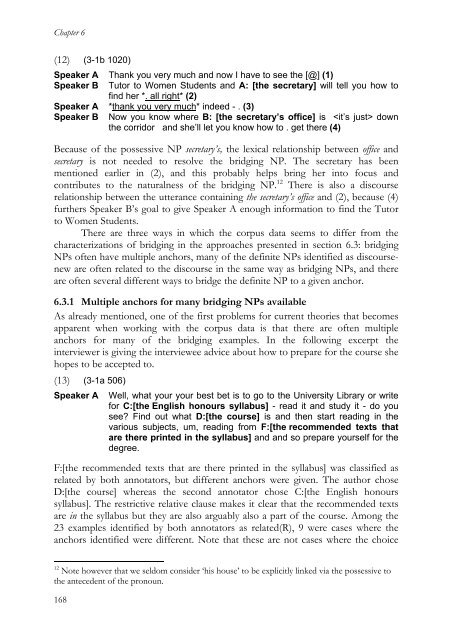Presuppositions in Spoken Discourse
Presuppositions in Spoken Discourse
Presuppositions in Spoken Discourse
Create successful ePaper yourself
Turn your PDF publications into a flip-book with our unique Google optimized e-Paper software.
Chapter 6<br />
(12) (3-1b 1020)<br />
Speaker A Thank you very much and now I have to see the [@] (1)<br />
Speaker B Tutor to Women Students and A: [the secretary] will tell you how to<br />
f<strong>in</strong>d her *. all right* (2)<br />
Speaker A *thank you very much* <strong>in</strong>deed - . (3)<br />
Speaker B Now you know where B: [the secretary’s office] is down<br />
the corridor and she’ll let you know how to . get there (4)<br />
Because of the possessive NP secretary’s, the lexical relationship between office and<br />
secretary is not needed to resolve the bridg<strong>in</strong>g NP. The secretary has been<br />
mentioned earlier <strong>in</strong> (2), and this probably helps br<strong>in</strong>g her <strong>in</strong>to focus and<br />
contributes to the naturalness of the bridg<strong>in</strong>g NP. 12 There is also a discourse<br />
relationship between the utterance conta<strong>in</strong><strong>in</strong>g the secretary’s office and (2), because (4)<br />
furthers Speaker B’s goal to give Speaker A enough <strong>in</strong>formation to f<strong>in</strong>d the Tutor<br />
to Women Students.<br />
There are three ways <strong>in</strong> which the corpus data seems to differ from the<br />
characterizations of bridg<strong>in</strong>g <strong>in</strong> the approaches presented <strong>in</strong> section 6.3: bridg<strong>in</strong>g<br />
NPs often have multiple anchors, many of the def<strong>in</strong>ite NPs identified as discoursenew<br />
are often related to the discourse <strong>in</strong> the same way as bridg<strong>in</strong>g NPs, and there<br />
are often several different ways to bridge the def<strong>in</strong>ite NP to a given anchor.<br />
6.3.1 Multiple anchors for many bridg<strong>in</strong>g NPs available<br />
As already mentioned, one of the first problems for current theories that becomes<br />
apparent when work<strong>in</strong>g with the corpus data is that there are often multiple<br />
anchors for many of the bridg<strong>in</strong>g examples. In the follow<strong>in</strong>g excerpt the<br />
<strong>in</strong>terviewer is giv<strong>in</strong>g the <strong>in</strong>terviewee advice about how to prepare for the course she<br />
hopes to be accepted to.<br />
(13) (3-1a 506)<br />
Speaker A Well, what your your best bet is to go to the University Library or write<br />
for C:[the English honours syllabus] - read it and study it - do you<br />
see? F<strong>in</strong>d out what D:[the course] is and then start read<strong>in</strong>g <strong>in</strong> the<br />
various subjects, um, read<strong>in</strong>g from F:[the recommended texts that<br />
are there pr<strong>in</strong>ted <strong>in</strong> the syllabus] and and so prepare yourself for the<br />
degree.<br />
F:[the recommended texts that are there pr<strong>in</strong>ted <strong>in</strong> the syllabus] was classified as<br />
related by both annotators, but different anchors were given. The author chose<br />
D:[the course] whereas the second annotator chose C:[the English honours<br />
syllabus]. The restrictive relative clause makes it clear that the recommended texts<br />
are <strong>in</strong> the syllabus but they are also arguably also a part of the course. Among the<br />
23 examples identified by both annotators as related(R), 9 were cases where the<br />
anchors identified were different. Note that these are not cases where the choice<br />
12<br />
Note however that we seldom consider ‘his house’ to be explicitly l<strong>in</strong>ked via the possessive to<br />
the antecedent of the pronoun.<br />
168











